Comparative Morphology and Ultrastructure of Antennal Sensilla in Dendrolimus superans (Lepidoptera: Lasiocampidae) and Lymantria dispar (Lepidoptera: Lymantriidae)
Abstract
Simple Summary
Abstract
1. Introduction
2. Materials and Methods
2.1. Insects
2.2. Scanning Electron Microscopy
3. Results
3.1. Antennal Morphology and Sensilla Types of D. superans
3.1.1. Morphology
Sensilla Trichoidea (ST)
Sensilla Chaetica (SCh)
Sensilla Coeloconica (SCo)
Sensilla Gemmiformia (SG)
Sensilla Basiconica (SB)
3.2. Antennal Morphology and Sensilla Types of L. dispar
3.2.1. Morphology
Sensilla Trichoidea (ST)
Sensilla Chaetica (SC)
Sensilla Coeloconica (SC)
Sensilla Styloconica (SSt)
Sensilla Basiconica (SB)
Sensilla Auricillica (SA)
Sensilla Squamiformia (SSq)
3.3. Comparison between the Antennal Sensilla of Two Moths
4. Discussion
5. Conclusions
Author Contributions
Funding
Data Availability Statement
Acknowledgments
Conflicts of Interest
Correction Statement
References
- Gao, Y.; Luo, L.Z.; Hammond, A. Antennal morphology, structure and sensilla distribution in Miroplitis pallidipes (Hymenoptera: Braconidae). Micron 2007, 38, 684–693. [Google Scholar] [CrossRef]
- Guo, J.; Du, Z.; Cui, G.; Wang, Z.; Wang, J.; Zhou, X. Ultrastructure Characteristics and Sexual Dimorphism of Antennal Sensilla in Tirathaba rufivena (Lepidoptera: Pyralidae). Insects 2022, 13, 797. [Google Scholar] [CrossRef] [PubMed]
- Altner, H.; Prillinger, L. Ultrastructure of invertebrate chemo-, thermo-, and hygroreceptors and its functional significance. Int. Rev. Cytol. 1980, 67, 69–139. [Google Scholar]
- Zacharuk, R.Y. Comprehensive insect physiology, biochemistry and pharmacology. In Insect Biochemistry; Kerkut, G.A., Gilbert, L.I., Eds.; Pergamon Press: Oxford, UK, 1985; Volume 6, pp. 1–69. [Google Scholar]
- Hansson, B.S.; Stensmyr, M.C. Evolution of insect olfaction. Neuron 2011, 72, 698–711. [Google Scholar] [CrossRef]
- Visser, J.H. Host odor perception in phytophagous insects. Annu. Rev. Entomol. 1986, 31, 121–144. [Google Scholar] [CrossRef]
- Gulyun, Y.; Thomas, W.P. Influence of tapeworm infection on the production of aggregation pheromone and defensive compoundsin Tribolium castaneum. J. Parasitol. 1996, 82, 1037–1039. [Google Scholar]
- Riesgo-Escovar, J.R.; Piekos, W.B.; Carlsom, J.R. The Drosophila antenna: Ultrastructual and physiological studies in wild-type and lozenge mutants. J. Comp. Physiol. A 1997, 180, 151–160. [Google Scholar] [CrossRef]
- Hunger, T.; Steinbrecht, R.A. Functional morphology of a doublewalled multiporous olfactory sensillum: The sensillum coeloconicum of Bombux mori (Insecta, Lepidoptera). Tissue Cell 1998, 30, 14–29. [Google Scholar] [CrossRef]
- Rebora, M.; Piersanti, S.; Gaino, E. The antennal sensilla of the adult of Libellula depressa (Odonata: Libellulidae). Arthropod Struct. Dev. 2008, 37, 504–510. [Google Scholar] [CrossRef]
- Onagbola, E.O.; Fadamiro, H.Y. Scanning electron microscopy studies of antennal sensilla of Pteromalus cerealellae (Hymenoptera: Pteromalidae). Micron 2008, 39, 526–535. [Google Scholar] [CrossRef] [PubMed]
- Silva, C.C.; de Capdeville, G.; Moraes, M.C.B.; Falcão, R.; Solino, L.F.; Laumann, R.A.; Silva, J.P.; Borges, M. Morphology, distribution and abundance of antennal sensilla in three stink bug species (Hemiptera: Pentatomidae). Micron 2010, 41, 289–300. [Google Scholar] [CrossRef]
- Zhou, C.-X.; Sun, X.; Mi, F.; Chen, J.; Wang, M.-Q. Antennal sensilla in the parasitoid Sclerodermus sp. (Hymenoptera: Bethylidae). J. Insect Sci. 2015, 15, 36. [Google Scholar] [CrossRef]
- Zhang, Y.J.; Chen, D.Y.; Chao, X.T.; Dong, Z.S.; Huang, Z.Y.; Zheng, X.L.; Lu, W. Morphological characterization and distribution of antennal sensilla of Diaphania angustalis Snellen (Lepidoptera: Crambidae). Microsc. Res. Tech. 2019, 82, 1632–1641. [Google Scholar] [CrossRef] [PubMed]
- Heppner, J.B. Butterflies and Moths (Lepidoptera). In Encyclopedia of Entomology; Springer: Dordrecht, The Netherlands, 2008. [Google Scholar]
- Hallberg, E.; Hansson, B.; Lofstedt, C. Lepidoptera, moths and butterflies: Morphology, physiology and development. Sensilla Proprioreceptors 2003, 2, 267–288. [Google Scholar]
- Zhao, L.; Bao-zhen, H.; Lu, L. Ultrastructure of the sensilla on larval antennae and mouthparts in the peach fruit moth, Carposina sasakii Matsumura (Lepidoptera: Carposinidae). Micron 2011, 42, 478–483. [Google Scholar]
- Agnès, F.N.-M.; Christian, U.; Renate, R.; Cornel, A. Structure and distribution of antennal sensilla in the Indianmeal moth, Plodia interpunctella (Hübner, 1813) (Lepidoptera: Pyralidae). J. Stored Prod. Res. 2014, 59, 66–75. [Google Scholar]
- Xu, J.; Deng, C.; Lu, W.; Wu, S. Ultrastructure of Antennal Sensilla in Adults of Dioryctria rubella Hampson (Lepidoptera: Pyralidae). Insects 2021, 12, 821. [Google Scholar] [CrossRef]
- Meng, Q.F.; Yang, X.G.; Yan, L.G.; Hong, G.Q.; Lin, L.; Liu, K.Y. Population characteristics of Dendrolims superans in Daxing’an Mountains. J. For. Res. 1997, 8, 227–230. [Google Scholar]
- Zhao, J.; Wu, Y.; Kurenshchikov, D.K.; Ilyinykh, A.V.; Shi, J. Underestimated mitochondrial diversity in gypsy moth Lymantria dispar from Asia. Agric. For. Entomol. 2019, 21, 235–242. [Google Scholar] [CrossRef]
- Zhang, Q. The occurrence pattern and prevention and control measures of D. superans. Mod. Rural Technol. 2023, 11, 35–36. (In Chinese) [Google Scholar]
- Zhao, M.D.; Zhang, T.; Liu, Y. The occurrence pattern and prevention and control measures of Lymantria dispar. Mod. Rural Technol. 2021, 12, 39–40. (In Chinese) [Google Scholar]
- Schaefer, P.W.; Yan, J.J.; Sun, X.L.; William, E.W.; Ronald, M.W. Study on natural enemies Chinese gypsy moth (Lymantria dispar L.). For. Sci. 1984, 20, 434–440. (In Chinese) [Google Scholar]
- Zhu, Q.; Wu, N.; Brożek, J.; Dai, W. Antennal Morphology and Sexual Dimorphism of Antennal Sensilla in Callitettix versicolor (Fabricius) (Hemiptera: Cercopidae). Insects 2019, 10, 56. [Google Scholar] [CrossRef] [PubMed]
- Schneider, D. Insect antennae. Annu. Rev. Entomol. 1964, 9, 103–122. [Google Scholar] [CrossRef]
- Keil, T.A. Morphology and development of the peripheral olfactory organs. In Insect Olfaction; Hansson, B.S., Ed.; Springer: Berlin/Heidelberg, Germany, 1999; pp. 5–47. [Google Scholar]
- Faucheux, M.J.; Kristensen, N.P.; Yen, S.H. The antennae of neopseustid moths: Morphology and phylogenetic implications, with special reference to the sensilla (Insect, Lepidoptera, Neopseustidae). Zool. Anz. 2006, 245, 131–142. [Google Scholar] [CrossRef]
- Nesreen, M.; Abd, E.; Michel, J.F. The mouthparts and sensilla of the adult tomato leafminer moth, Tuta absoluta (Meyrick, 1917) (Lepidoptera: Gelechiidae). Arthropod Struct. Dev. 2022, 67, 101144. [Google Scholar]
- Liu, L.; Zhang, Y.; Yan, S.-C.; Yang, B.; Wang, G.-R. Ultrastructural and Descriptive Study on the Adult Body Surface of Heortia vitessoides (Lepidoptera: Crambidae). Insects 2023, 14, 687. [Google Scholar] [CrossRef]
- Le, R.B.; Renard, S.; Allo, M.R.; Lannic, J.R.; Rolland, J.P. Antennal sensilla and their possible functions in the host-plant selection behaviour of Phenacoccus manihoti (Matile-Ferrero) (Homoptera: Pseudococcidae). Int. J. Insect Morphol. Embryol. 1995, 24, 375–389. [Google Scholar]
- Rani, A.T.; Shashank, P.R.; Meshram, N.M.; Sagar, D.; Srivastava, C.; Pandey, K.K.; Singh, J. Morphological characterization of antennal sensilla of Earias vittella (Fabricius) (Lepidoptera: Nolidae). Micron 2021, 140, 102957. [Google Scholar] [CrossRef]
- Bjorksten, T.A.; Robinson, M.; Salle, J.L. Species compositionand population dynamics of leafminer flies and their parasitoids in Victoria. Aust. J. Entomol. 2005, 44, 186–191. [Google Scholar] [CrossRef]
- Hallberg, E.B.S.; Steinbrecht, R.A. Morphological characteristics of antennal sensilla in the European cornborer Ostrinia nubilslis (Lepidoptera: Pyralidae). Tissue Cell 1994, 26, 489–502. [Google Scholar] [CrossRef]
- Pérez-Aparicio, A.; Ammagarahalli, B.; Gemeno, C. A closer look at sex pheromone autodetection in the Oriental fruit moth. Sci. Rep. 2022, 12, 7019. [Google Scholar] [CrossRef] [PubMed]
- Al-Dosary, M.M. Morphological characterization of the antennal sensilla of the earwig Anisolabis maritima (Dermaptera:Carcinophoridae) with reference to their probable functions. Saudi J. Biol. Sci. 2009, 16, 17–22. [Google Scholar] [CrossRef] [PubMed]
- Dai, H.G.; Honda, H. Sensilla on the antennal flagellum of the yellow spotted longicorn beetle, Psacothea hilaris (Pascoe) (Coleoptera: Cerambycidae). Appl. Entomol. Zool. 1990, 25, 273–282. [Google Scholar] [CrossRef]
- Enno, M.; Angela, P.; Märt, R.; José, B.; Hans, P.R.; Anne, L.; Väino, S. Antennal sensilla of the ground beetle Bembidion properans Steph. (Coleoptera, Carabidae). Micron 2002, 33, 429–440. [Google Scholar]
- Hu, F.; Zhang, G.N.; Wang, J.J. Scanning electron microscopy studies of antennal sensilla of bruchid beetles, Callosobruchus chinensis (L.) and Callosobruchus maculatus (F.) (Coleoptera: Bruchidae). Micron 2009, 40, 320–326. [Google Scholar] [CrossRef]
- Guilherme, M.L.; Ricardo, B.; Duane, B.F. Antennal morphology and sensilla ultrastructure of Ascia monuste (Linnaeus) (Lepidoptera: Pieridae). Micron 2021, 142, 103000. [Google Scholar]
- Sad, I.; Tauban, D.; Renou, M.; Mori, K.; Rochat, D. Structure and function of the antennal sensilla of the palm weevil Rhynchophorus palmarum (Coleoptera, Curculionidae). J. Insect Physiol. 2003, 49, 857–872. [Google Scholar] [CrossRef]
- Merivee, E.; Rahi, M.; Bresciani, J.; Ravn, H.P.; Luik, A. Antennal sensilla of the click beetle, Limonius aeruginosus (Olivier) (Coleoptera: Elateridae). Int. J. Insect Morphol. Embryol. 1998, 27, 311–318. [Google Scholar] [CrossRef]
- Merivee, E.; Rahi, M.; Luik, A. Antennal sensilla of the click beetle, Melanotus villosus (Geoffroy) (Coleoptera: Elateridae). Int. J. Insect Morphol. Embryol. 1999, 28, 41–51. [Google Scholar] [CrossRef]
- Bartlet, E.; Romani, R.; Williams, I.H.; Isidoro, N. Functional anatomy of sensory structures on the antennae of Psylliodes chrysocephala L. (Coleoptera: Chrysomelidae). Int. J. Insect Morphol. Embryol. 1999, 28, 291–300. [Google Scholar] [CrossRef]
- Yang, H.; Yan, S.-C.; Liu, D. Ultrastructural observations on antennal sensilla of Coleophora obducta (Meyrick) (Lepidoptera: Coleophoridae). Micron 2008, 40, 234–238. [Google Scholar] [CrossRef] [PubMed]
- Wang, G.R.; Guo, Y.Y.; Wu, K.M. Observation on the Ultrastructures of Antennal Sensilla in Helivoverpa armigera. Sci. Agric. Sin. 2002, 35, 1479–1482. (In Chinese) [Google Scholar]
- Li, G.Q.; Tan, Z.H.; Lin, H.H.; Wen, Y.B.; Zhang, J.F.; Wu, H.X.; Xie, M.Q. SEM Observation on Sense Organs of Culicoides arakawae and Culicoides schultzei. J. South China Agric. Univ. 2000, 21, 72–75. (In Chinese) [Google Scholar]
- Bruce, T.J.; Cork, A. Electrophysiological and behavioral responses of female Helicoverpa armigera to compounds identified in flowers of African marigold, Tagetes erecta. J. Chem. Ecol. 2001, 27, 1119–1131. [Google Scholar] [CrossRef] [PubMed]
- Isidoro, N.; Solinas, M. Functional morphology of the antennal chemosensilla of Ceutorhynchus assimilis Payk. (Coleoptera: Curculionidae). Entomologica 1992, 27, 69–84. [Google Scholar]
- Okada, K.; Watanabe, A.; Mori, M.; Shimazaki, K.; Nishi, Y.; Sato, S. Fine structure of antennal sex-pheromone-sensitive sensilla of the male cigarette beetle, Lasioderma serricorne (Coleoptera: Anobiidae). Appl. Entomol. Zool. 1993, 28, 283–289. [Google Scholar]
- Liu, Y.S.; Shi, F.M. Observation on antennal sensilla of Buprestis fairmairei Thery (Coleoptera, Buprestidae) with scanning electron microscopy. Acta Entomol. Sin. 2005, 48, 469–472. (In Chinese) [Google Scholar]
- Laue, M. Immunolocalization of general odorant-binding protein in antennal sensilla of moth caterpillars. Arthropod Struct. Dev. 2000, 29, 57–73. [Google Scholar] [CrossRef]
- Zhang, Z.F.; Wu, W.J.; Liang, G.W. The ultra-structure of sensilla in antennae of Fruhstoferiola tonkinensis. Chin. Bull. Entomol. 2005, 42, 431–434. (In Chinese) [Google Scholar]
- Gao, S.H.; Ji, Z.X.; Wang, C.Q. Observation on Antenna Sensillum of Sinopticu lasinica Yang by Using Scanning Electron Microscope. J. Anhui Agric. Sci. 2010, 38, 3499–3502. (In Chinese) [Google Scholar]
- Kvello, P.; Almaas, T.J.; Mustaparta, H. A confined taste area in a lepidopteran brain. Arthropod Struct. Dev. 2006, 35, 35–45. [Google Scholar] [CrossRef] [PubMed]
- Ma, R.Y.; Du, J.W. Insect sensilla. Entomol. Knowl. 2000, 37, 179–183. (In Chinese) [Google Scholar]
- Razowski, J.; Wojtusiak, J. Some data on sensilla and sculpture of antenna in adult Tortricidae (Insecta: Lepidoptera). Genus 2004, 15, 257–266. [Google Scholar]
- Anderson, P.; Hallberg, E.; Subchev, M. Morphology of antennal sensilla auricillica and their detection of plant volatiles in the herald moth, Scolioptery xlibatrix L.(Lepidoptera:Noctuidae). Arthropod Struct. Dev. 2000, 29, 33–41. [Google Scholar] [CrossRef] [PubMed]
- Xu, J. Morphological studies on the types and distribution of antennal sensilla in Spodeptera exigua (Hübner). J. Northwest A F Univ. 2008, 36, 189–193. (In Chinese) [Google Scholar]
- Ansebo, L.; Ignell, R.; Lofqvist, J. Responses to sex pheromone and plant odours by olfactory receptor neurons housed in sensilla auricillica of the codling moth, Cydia pomonella (Lepidoptera: Tortricidae). J. Insect Physiol. 2005, 51, 1066–1074. [Google Scholar] [CrossRef]
- Lavoie, D.J.; McNeil, J.N. Sensilla of the antennal flagellum in Pseudaletia unipuncta (Haw.) (Lepidoptera: Noctuidae). Int. J. Insect Morphol. Embryol. 1987, 16, 153–167. [Google Scholar] [CrossRef]
- Faucheux, M.J. Antennal sensilla in adult Agathiphaga vitiensis dumbl. and A. queenslandensis dumbl. (Lepidoptera: Agathiphagidae). Int. J. Insect Morphol. Embryol. 1990, 19, 257–268. [Google Scholar] [CrossRef]
- Castrejón-Gómez, V.R.; Nieto, G.; Valdes, J.; Castrejon, F.; Rojas, J.C. The antennal sensilla of Zamagiria dixolophella Dyar (Lepidoptera: Pyralidae). Ann. Entomol. Soc. Amer. 2003, 96, 672–678. [Google Scholar] [CrossRef]
- Yu, H.Z. Types of Antennal Sensilla and Partial Cloning and Sequence Analysis of the General Odorant Binding Proteins 2 Gene of the Stripe Stem Borer Chilo supprssalis (Walker). Master’s Dissertation, Zhejiang University, Hangzhou, China, 2004; pp. 1–74. (In Chinese). [Google Scholar]
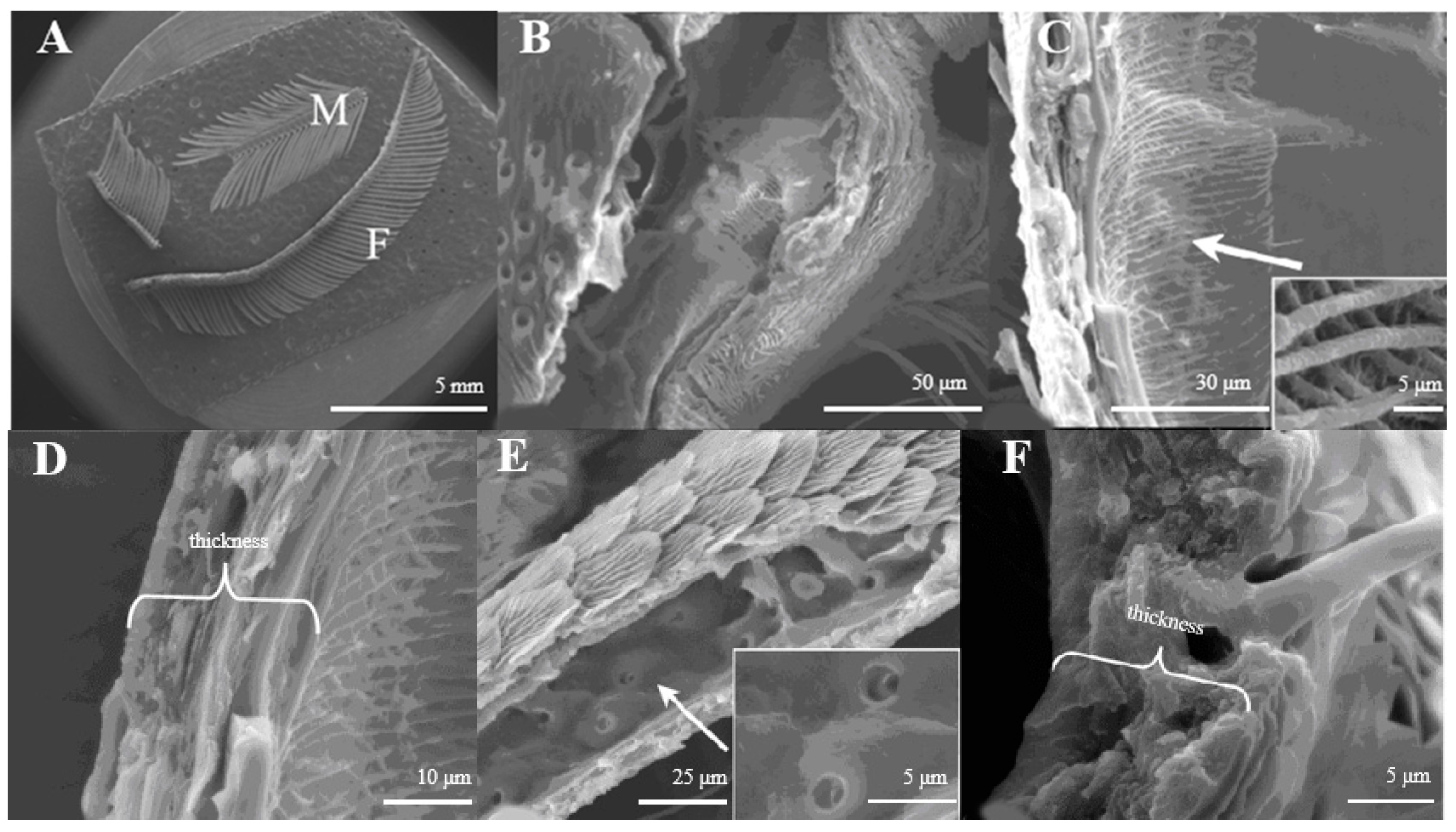

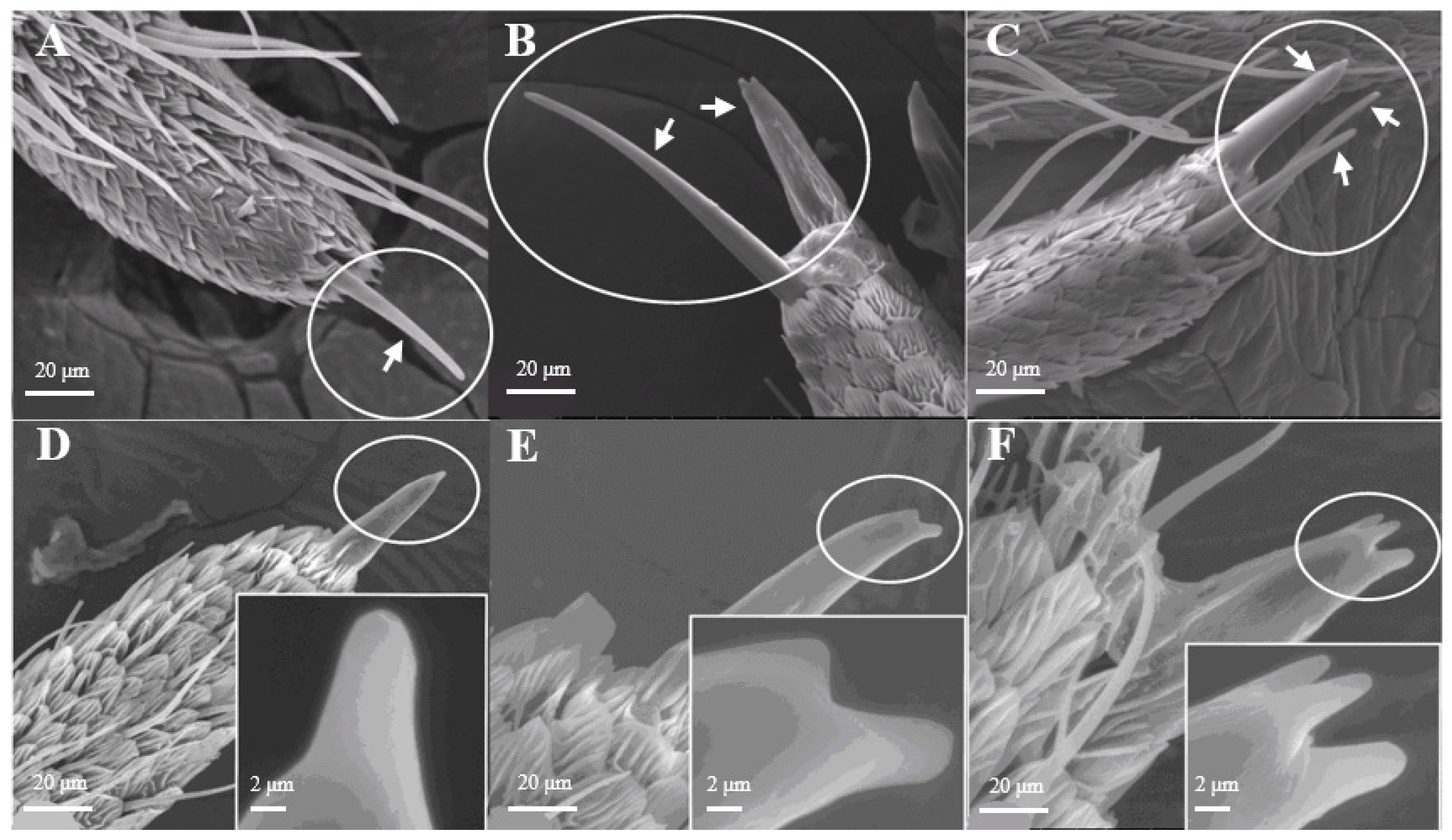


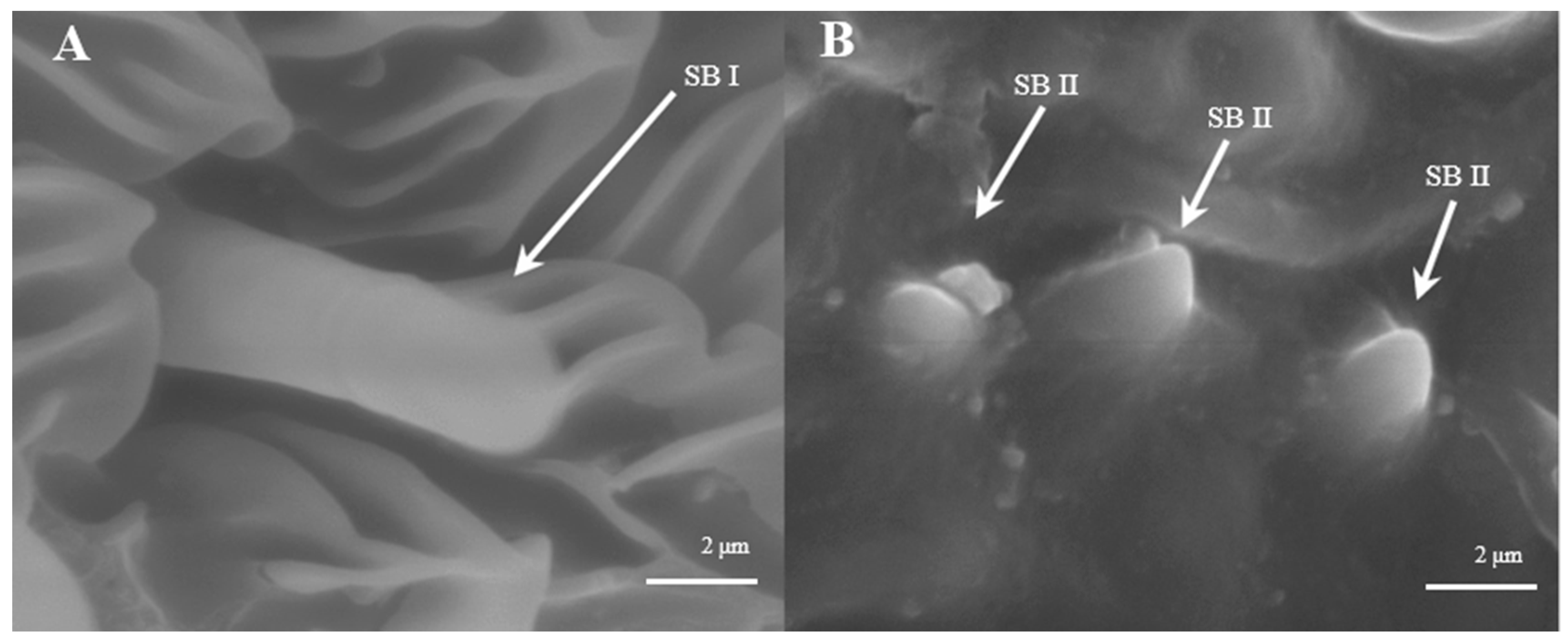
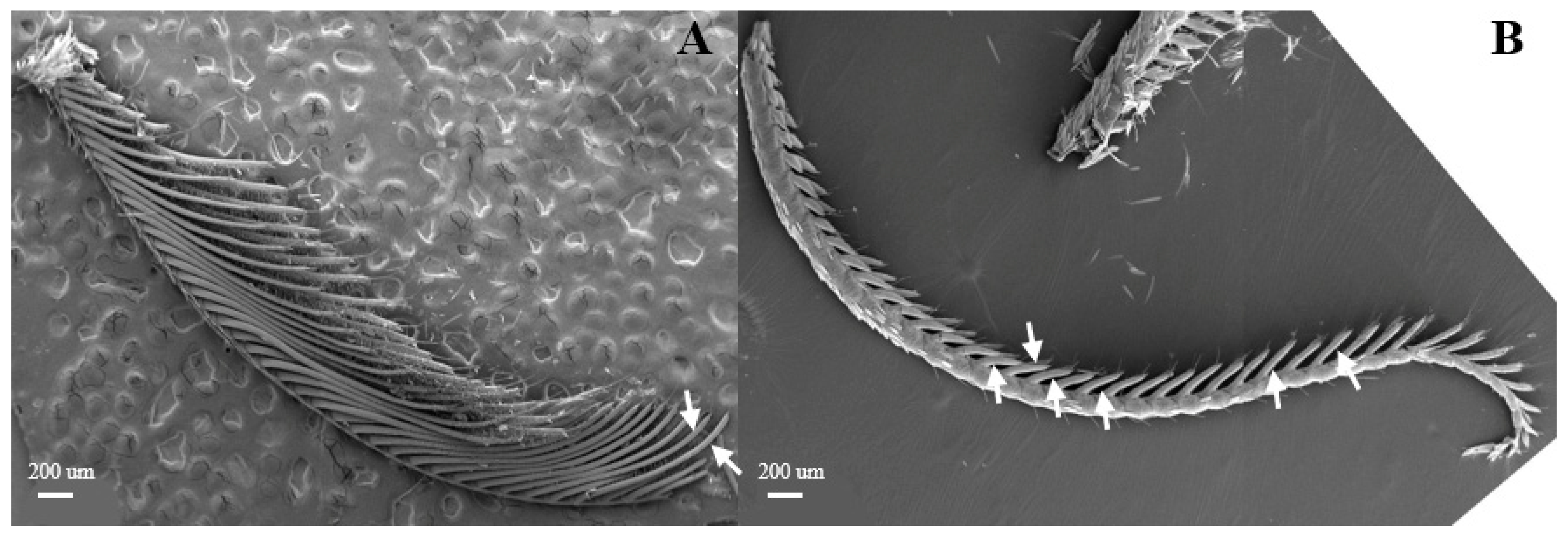

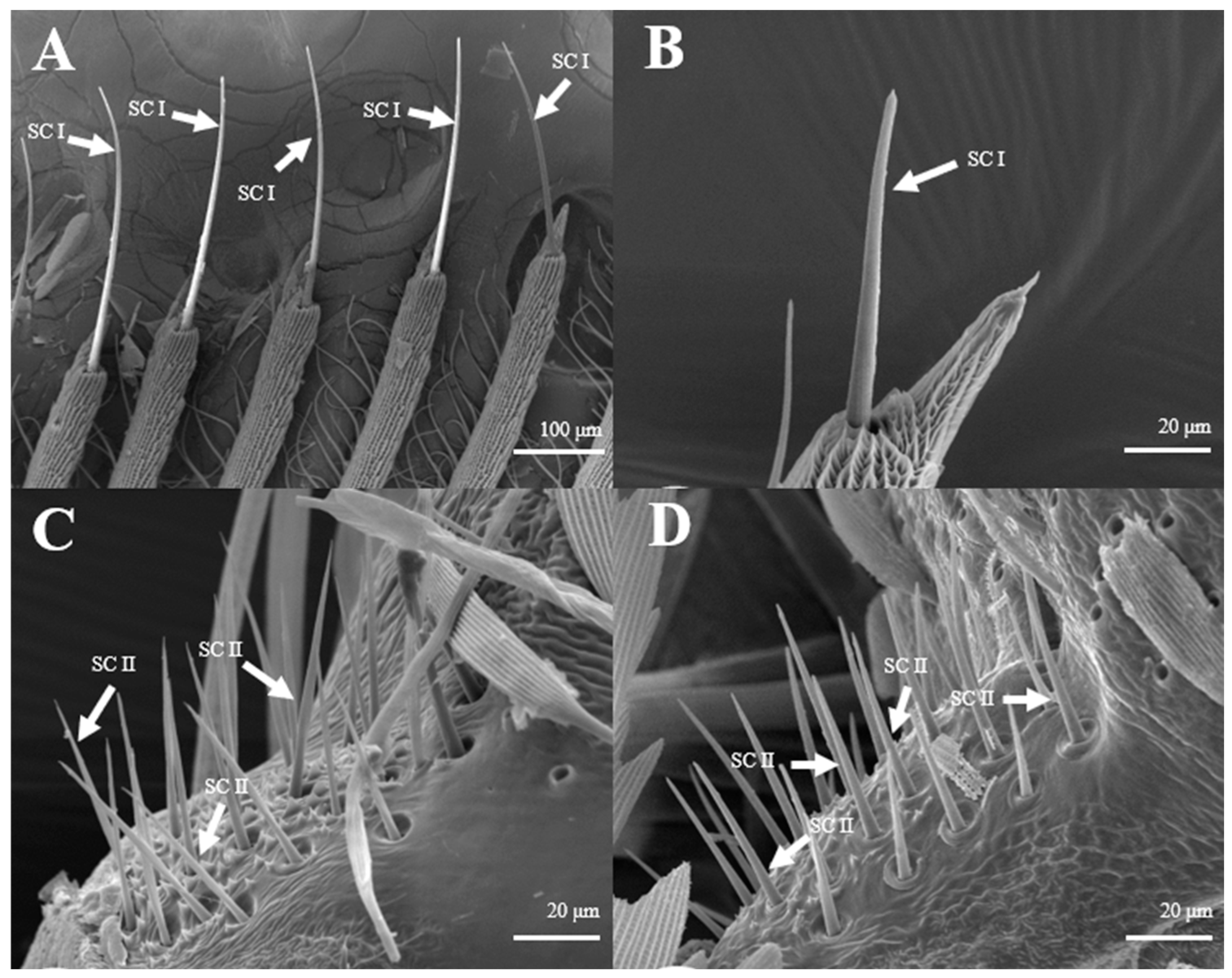




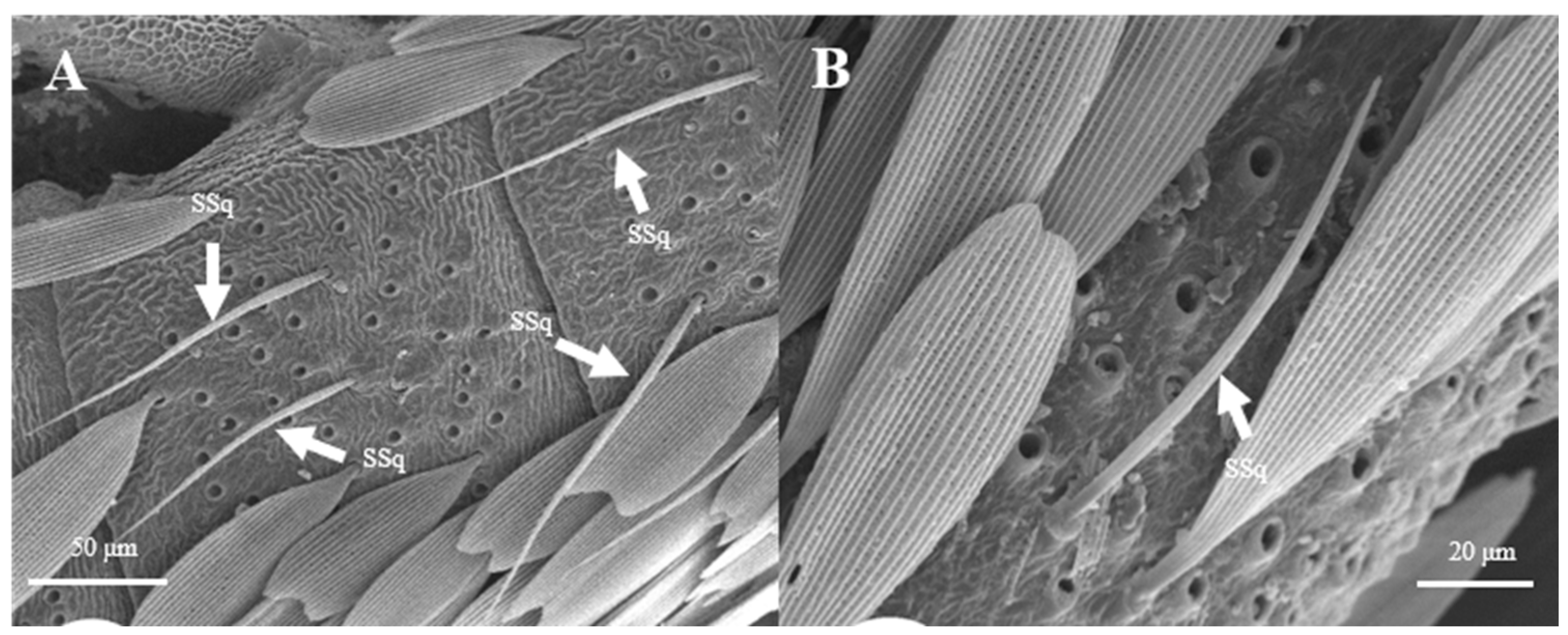
| Sensilla Types | Sub-Types | D. superans | Sub-Types | L. dispar | ||
|---|---|---|---|---|---|---|
| Length (μm) | Basal Width (µm) | Length (μm) | Basal Width (µm) | |||
| Sensilla trichoidea | s. trichoidea I | 62–64 | 1.3–1.4 | s. trichoidea I | 151.5–151.6 | 34.1–34.3 |
| s. trichoidea II | 23–25 | 2.2–2.3 | s. trichoidea II | 31.9–32.1 | 2.4–2.5 | |
| Sensilla chaetica | —— | 27–29 | 3.5–3.6 | s. chaetica I | 281.6–281.7 (♂) | 12.0–12.1 (♂) |
| 76.0–76.2 (♀) | 6.53 (♀) | |||||
| s. chaetica II | 32.8–33.0 | 2.65 | ||||
| Sensilla coeloconica | s. coeloconica I | —— | 4.5–5.1 | —— | —— | 9.7–9.8 |
| s. coeloconica II | ||||||
| Sensilla basiconica | s. basiconica I | 3.5–3.6 | —— | s. basiconica I | 9.3–9.4 | —— |
| s. basiconica II | 1.3–1.4 | —— | s. basiconica II | 2.0–2.2 | —— | |
| Sensilla gemmiformia | s. gemmiformia I | 2.8–3.0 | 2.5–2.7 | |||
| s. gemmiformia II | ||||||
| Sensilla styloconica | —— | 6.4–6.5 | 2.3–2.4 | |||
| Sensilla auricillica | —— | —— | —— | |||
| Sensilla squamiformia | —— | 110.8–111.0 | 2.5–3.0 | |||
Disclaimer/Publisher’s Note: The statements, opinions and data contained in all publications are solely those of the individual author(s) and contributor(s) and not of MDPI and/or the editor(s). MDPI and/or the editor(s) disclaim responsibility for any injury to people or property resulting from any ideas, methods, instructions or products referred to in the content. |
© 2024 by the authors. Licensee MDPI, Basel, Switzerland. This article is an open access article distributed under the terms and conditions of the Creative Commons Attribution (CC BY) license (https://creativecommons.org/licenses/by/4.0/).
Share and Cite
Wang, Q.; Wang, L.; Wang, Q.; Yan, S. Comparative Morphology and Ultrastructure of Antennal Sensilla in Dendrolimus superans (Lepidoptera: Lasiocampidae) and Lymantria dispar (Lepidoptera: Lymantriidae). Insects 2024, 15, 655. https://doi.org/10.3390/insects15090655
Wang Q, Wang L, Wang Q, Yan S. Comparative Morphology and Ultrastructure of Antennal Sensilla in Dendrolimus superans (Lepidoptera: Lasiocampidae) and Lymantria dispar (Lepidoptera: Lymantriidae). Insects. 2024; 15(9):655. https://doi.org/10.3390/insects15090655
Chicago/Turabian StyleWang, Qi, Longzheng Wang, Qing Wang, and Shanchun Yan. 2024. "Comparative Morphology and Ultrastructure of Antennal Sensilla in Dendrolimus superans (Lepidoptera: Lasiocampidae) and Lymantria dispar (Lepidoptera: Lymantriidae)" Insects 15, no. 9: 655. https://doi.org/10.3390/insects15090655
APA StyleWang, Q., Wang, L., Wang, Q., & Yan, S. (2024). Comparative Morphology and Ultrastructure of Antennal Sensilla in Dendrolimus superans (Lepidoptera: Lasiocampidae) and Lymantria dispar (Lepidoptera: Lymantriidae). Insects, 15(9), 655. https://doi.org/10.3390/insects15090655




